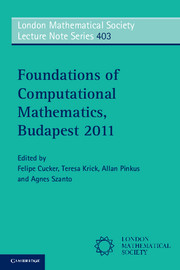Book contents
- Frontmatter
- Contents
- Preface
- Contributors
- 1 The State of the Art in Smale's 7th Problem
- 2 The Shape of Data
- 3 Upwinding in Finite Element Systems of Differential Forms
- 4 On the Complexity of Computing Quadrature Formulas for SDEs
- 5 The Quantum Walk of F. Riesz
- 6 Modulated Fourier Expansions for Continuous and Discrete Oscillatory Systems
- 7 The Dual Role of Convection in 3D Navier-Stokes Equations
- 8 Algebraic and Differential Invariants
- 9 Through the Kaleidoscope: Symmetries, Groups and Chebyshev-Approximations from a Computational Point of View
- 10 Sage: Creating a Viable Free Open Source Alternative to Magma, Maple, Mathematica, and MATLAB
- References
3 - Upwinding in Finite Element Systems of Differential Forms
Published online by Cambridge University Press: 05 December 2012
- Frontmatter
- Contents
- Preface
- Contributors
- 1 The State of the Art in Smale's 7th Problem
- 2 The Shape of Data
- 3 Upwinding in Finite Element Systems of Differential Forms
- 4 On the Complexity of Computing Quadrature Formulas for SDEs
- 5 The Quantum Walk of F. Riesz
- 6 Modulated Fourier Expansions for Continuous and Discrete Oscillatory Systems
- 7 The Dual Role of Convection in 3D Navier-Stokes Equations
- 8 Algebraic and Differential Invariants
- 9 Through the Kaleidoscope: Symmetries, Groups and Chebyshev-Approximations from a Computational Point of View
- 10 Sage: Creating a Viable Free Open Source Alternative to Magma, Maple, Mathematica, and MATLAB
- References
Summary
Abstract
We provide a notion of finite element system, that enables the construction of spaces of differential forms, which can be used for the numerical solution of variationally posed partial differential equations. Within this framework, we introduce a form of upwinding, with the aim of stabilizing methods for the purposes of computational fluid dynamics, in the vanishing viscosity regime.
Foreword
I am deeply honored to have received the first Stephen Smale prize from the Society for the Foundations of Computational Mathematics.
I want to thank the jury for deciding, in what I understand was a difficult weighing process, to tip the balance in my favor. The tiny margins that similarly enable the Gömböc to find its way to equilibrium, give me equal pleasure to contemplate. It's a beautiful prize trophy.
It is a great joy to receive a prize that celebrates the unity of mathematics. I hope it will draw attention to the satisfaction there can be, in combining theoretical musings with potent applications. Differential geometry, which infuses most of my work, is a good example of a subject that defies perceived boundaries, equally appealing to craftsmen of various trades.
As I was entering the subject, rumors that Smale could turn spheres inside out without pinching, were among the legends that gave it a sense of surprise and mystery. I also remember reading about Turing machines built on rings other than ℤ/2ℤ, which, together with parallelism and quantum computing, convinced me that the foundations of our subject were still in the making.
- Type
- Chapter
- Information
- Foundations of Computational Mathematics, Budapest 2011 , pp. 45 - 71Publisher: Cambridge University PressPrint publication year: 2012
References
- 2
- Cited by

